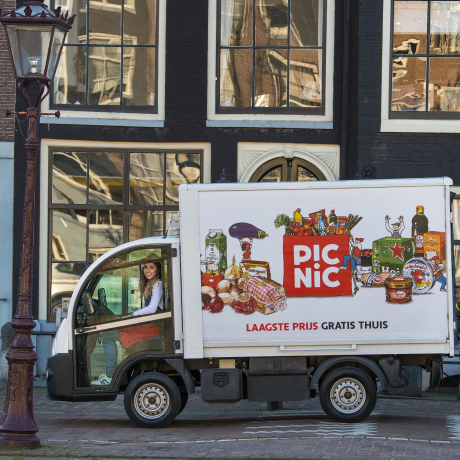Picnic is a Dutch grocery delivery service that’s app-based, eco-friendly, and fast. Launched in 2015, it delivers groceries with electric vehicles and operates without physical stores, using a low-inventory model to cut waste and save costs. Picnic’s smart delivery routes optimize neighborhood drops, reducing emissions and delivery times. Now expanding from the Netherlands into Germany and France, Picnic is reshaping online grocery shopping across Europe with affordable, sustainable solutions.
Last year was a huge milestone, with 40% growth and €1.25 billion in sales.
Picnic has used Slack since day one. It is the collaboration platform on which the company plans future growth and where its corporate culture is enhanced.

“Everyone here grew up with Slack. It’s the main way we communicate and it’s how we interact.”
Designing the right formula for growth
Picnic aims to spread its blanket wide. Launched in Amersfoort, Holland, barely 10 years ago, the online grocery delivery startup has since appeared in every major city in the Netherlands, expanded into France and Germany, and mushroomed its workforce. And it’s no secret that this ambitious young company wants to extend its reach still further into Europe.
The ingredients to success? “Start small, focus on quality, and only expand when you’ve got it right,” said Jelmer Borst, Picnic’s enthusiastic Domain Lead Analytics & Machine Learning. And get it right they do, with guaranteed low prices, quality products, no delivery fees, and precise drop-off times.
Another key element has been Slack. “Everyone here grew up with Slack,” said Borst. “It’s the main way we communicate and interact.” For what began life as a small group of people with a big vision and a desire to foster an open and collaborative culture, Slack was seen as an essential and ultimately compatible tool: flexible, transparent, and easy-to-use.
“What stood out about Slack is that it allows for organic communication — you can self-organize instead of having a lot of structured function,” said Borst. “When you’re 20 people trying to start a company together, you want to feel like you’re talking to your friends. With Slack, anyone can have an idea or start a new project and get it off the ground.”
Today, all of Picnic’s 15,000 employees, from software architects and IT support to warehouse staff and delivery drivers, can connect seamlessly on Slack. Many of Picnic’s thousands of workflows — access approval, for example — have been automated on it. Previously, users had to create a ticket and then someone else would have to review it and grant permission. Now, with a Slack bot user approver, users simply receive a message, select ‘approve,’ and the access process is automated.
“When you’re 20 people trying to start a company together, you want to feel like you’re talking to your friends. With Slack, anyone can have an idea or start a new project and get it off the ground.”
Integrating AI for enhanced functionality
Ever the innovator, Picnic prioritized the integration of AI into its operations from the outset, building third-party AI tools within Slack. As Borst put it, “We’re an AI-first company.” This commitment has enabled Picnic to optimize various aspects of its business, from demand and supply chain forecasting to customer personalization and security through the development of around 50 different homegrown models.
“Within two weeks of ChatGPT launching, we were using gen AI in Slack, and now we want everyone at Picnic to be using it! Given that everyone’s already in Slack, we want to bring this powerful technology to everyone, instead of them going to different tools,” said Borst.
Its own in-house agent, Picnic AI, built using Slack’s recently released agent APIs, offers advanced functionality to streamline information access and enhance productivity across teams. Designed to leverage context, the AI adjusts prompts based on the channel’s topic, such as finance or logistics, to provide relevant information and guidance. Users can request coding or summarization assistance — a branching logic means code-related questions default to Anthropic and text-related questions to ChatGPT, a triage functionality unseen by the user. The AI buzzes slowly to indicate that it’s thinking before responding to questions — a new feature of these agents. Meanwhile, user feedback given via positive or negative emoji enables Picnic to iterate and retest prompts.
Picnic AI enables users to stay easily updated on company news from its different regions — the Netherlands, Germany, and France — by summarizing relevant messages from designated Slack channels. When a user requests updates, Picnic AI pulls information from the news channel, generates a summary, and automatically translates it into the user’s language. That summary can be posted in the thread for everyone to reference. Quickly summarizing long threads containing hundreds of messages, so that colleagues coming late to a situation can be apprised of it in minutes, has optimized information retrieval across Picnic’s distributed teams. “It’s helped us tremendously in dealing with time-critical incidents,” said Borst.

Pioneering creative solutions to drive efficiencies
One of the key ways in which Picnic has used AI is by transforming structured data into actionable insights. “We now have the ability to work with unstructured data — pieces of text floating around,” said Borst. “Being able to extract information from those pieces of text allows us to automate manual work.” This has unlocked a range of possibilities, enabling Picnic to automate tasks such as writing product descriptions and freeing up valuable time and resources.
This innovative spirit is also evident in Picnic’s experimenting with AI to generate a bite-size daily ‘podcast,’ summarizing key company news from multiple unread Slack channels across the organization. As Borst said, “There are 20 or 30 channels that I’m super-active in, but there’s so much other stuff happening in Picnic I’d like to follow that I don’t have time to read.” Conceived by Borst, the concise audio digest — delivered in the voice of Picnic’s CEO — offers employees a convenient way to stay informed of news, be it on their way to work or at their desk. This creative use of AI showcases Picnic’s commitment to leveraging technology to improve internal communication, enhance productivity, and keep everyone — from delivery drivers to marketing teams — on the same page.
Opening up a future of potential through agent-driven action
Looking ahead, Picnic sees exciting potential to enhance integration and streamline processes. Expanding its ability to pull in more external sources — from Confluence to GitHub and beyond — will enrich the information accessible within Slack, complementing the extensive data already available. Picnic aims to build on this, embedding more agent-driven actions directly within Slack, where it already actively uses thousands of workflows.
“Building AI with Slack’s new agent APIs is really promising,” said Borst. “I think the experience is overall a lot nicer for people — the fact that you can pull it into a sideboard and have a more intuitive way of seeing when it’s thinking about your question.”
Jorst is excited, too, about the integration with canvases, and he and the Picnic team are collaborating closely with Slack to refine these capabilities.
“We’re already performing agent-driven actions outside of Slack in different ways,” said Borst. “Being able to do that within Slack, where we have thousands of workflows, and utilizing AI in those workflows as well — it’s going to be a big one.”















